A Dual-Function Instantaneous Power Theory for Operation of Three-Level Neutral-Point-Clamped Inverter-Based Shunt Active Power Filter
Abstract
:1. Introduction
2. Shunt Active Power Filter: Circuit Connection and Control Structure
3. Dual-Function Instantaneous Power Theory Algorithm
3.1. The Existing Theory Algorithm
3.2. The Three Proposed Enhancements
- (1)
- Compute magnitude of based on the values of and which is obtained using Equation (3).
- (2)
- Divide directly with the generated magnitude .
4. Simulation Results
4.1. Steady-State Condition Analysis
4.2. Dynamic-State Condition Analysis
5. Experimental Verification
6. Conclusions
Author Contributions
Conflicts of Interest
References
- Choi, W.-H.; Lam, C.-S.; Wong, M.-C.; Han, Y.-D. Analysis of dc-link voltage controls in three-phase four-wire hybrid active power filters. IEEE Trans. Power Electron. 2013, 28, 2180–2191. [Google Scholar] [CrossRef]
- Kale, M.; Ozdemir, E. An adaptive hysteresis band current controller for shunt active power filter. Electr. Power Syst. Res. 2005, 73, 113–119. [Google Scholar] [CrossRef]
- Akagi, H. Active harmonic filters. Proc. IEEE 2005, 93, 2128–2141. [Google Scholar] [CrossRef]
- Green, T.C.; Marks, J.H. Control techniques for active power filters. IEE Proc. Electr. Power Appl. 2005, 152, 369–381. [Google Scholar] [CrossRef]
- Asiminoaei, L.; Blaabjerg, F.; Hansen, S. Detection is key-harmonic detection methods for active power filter applications. IEEE Ind. Appl. Mag. 2007, 13, 22–33. [Google Scholar] [CrossRef]
- Chudamani, R.; Vasudevan, K.; Ramalingam, C.S. Non-linear least-squares-based harmonic estimation algorithm for a shunt active power filter. IET Power Electron. 2009, 2, 134–146. [Google Scholar] [CrossRef]
- Eskandarian, N.; Beromi, Y.A.; Farhangi, S. Improvement of dynamic behavior of shunt active power filter using fuzzy instantaneous power theory. J. Power Electron. 2014, 14, 1303–1313. [Google Scholar] [CrossRef]
- Wang, L.; Lam, C.-S.; Wong, M.-C. Unbalanced control strategy for a thyristor-controlled LC-coupling hybrid active power filter in three-phase three-wire systems. IEEE Trans. Power Electron. 2017, 32, 1056–1069. [Google Scholar] [CrossRef]
- Popescu, M.; Bitoleanu, A.; Suru, V. A DSP-based implementation of the p-q theory in active power filtering under nonideal voltage conditions. IEEE Trans. Ind. Inform. 2013, 9, 880–889. [Google Scholar] [CrossRef]
- Pigazo, A.; Moreno, V.M.; Estebanez, E.J. A recursive park transformation to improve the performance of synchronous reference frame controllers in shunt active power filters. IEEE Trans. Ind. Electron. 2009, 24, 2065–2075. [Google Scholar] [CrossRef]
- Monfared, M.; Golestan, S.; Guerrero, J.M. A new synchronous reference frame-based method for single-phase shunt active power filters. J. Power Electron. 2013, 13, 692–700. [Google Scholar] [CrossRef]
- Musa, S.; Radzi, M.A.M.; Hizam, H.; Wahab, N.I.A.; Hoon, Y.; Zainuri, M.A.A.M. Modified synchronous reference frame based shunt active power filter with fuzzy logic control pulse width modulation inverter. Energies 2017, 10, 758. [Google Scholar] [CrossRef]
- Vodyakho, O.; Mi, C.C. Three-level inverter-based shunt active power filter in three-phase three-wire and four-wire systems. IEEE Trans. Power Electron. 2009, 24, 1350–1363. [Google Scholar] [CrossRef]
- Sujitjorn, S.; Areerak, K.-L.; Kulworawanichpong, T. The dq axis with Fourier (dqF) method for harmonic identification. IEEE Trans. Power Deliv. 2007, 22, 737–739. [Google Scholar] [CrossRef]
- Bhattacharya, A.; Chakraborty, C. A shunt active power filter with enhanced performance using ANN-based predictive and adaptive controllers. IEEE Trans. Ind. Electron. 2011, 58, 421–428. [Google Scholar] [CrossRef]
- Abdeslam, D.O.; Wira, P.; Merckle, J.; Flieller, D.; Chapuis, Y.-A. A unified artificial neural network architecture for active power filters. IEEE Trans. Ind. Electron. 2007, 54, 61–76. [Google Scholar] [CrossRef]
- Wang, H.; Li, Q.; Wu, M. Investigation on a new algorithm for instantaneous reactive and harmonic currents detection applied to intensive nonlinear loads. IEEE Trans. Power Deliv. 2007, 22, 2312–2318. [Google Scholar] [CrossRef]
- Ng, C.H.; Busawon, K.; Putrus, G.A.; Ran, L. Fast-individual-harmonic-extraction technique. IEE Proc. Gener. Transm. Distrib. 2005, 152, 556–562. [Google Scholar] [CrossRef]
- Rodriguez, P.; Pou, J.; Bergas, J.; Candela, J.I.; Burgos, R.P.; Boroyevich, D. Decoupled double synchronous reference frame PLL for power converters control. IEEE Trans. Power Electron. 2007, 22, 584–592. [Google Scholar] [CrossRef]
- Campanhol, L.B.G.; Silva, S.A.O.; Goedtel, A. Application of shunt active power filter for harmonic reduction and reactive power compensation in three-phase four-wire systems. IET Power Electron. 2014, 7, 2825–2836. [Google Scholar] [CrossRef]
- Mailah, N.F.; Hoon, Y.; Radzi, M.A.M. Dc-link capacitor voltage regulation with effort-reduction fuzzy logic control for three-level inverter-based shunt active power filter. Pertanika J. Sci. Technol. 2017, 25, 11–20. [Google Scholar]
- Hoon, Y.; Radzi, M.A.M.; Hassan, M.K.; Mailah, N.F. Dc-link capacitor voltage regulation for three-phase three-level inverter-based shunt active power filter with inverted error deviation control. Energies 2016, 9, 533. [Google Scholar] [CrossRef]
- Hoon, Y.; Radzi, M.A.M.; Hassan, M.K.; Mailah, N.F. A simple neutral-point voltage deviation minimization method for three-level inverter-based shunt active power filter. Int. J. Simul. Syst. Sci. Technol. 2016, 17, 33.31–33.36. [Google Scholar]
- Bhalodi, K.H.; Agarwal, P. Space vector modulation with dc-link voltage balancing control for three-level inverters. ACEEE Int. J. Commun. 2010, 1, 14–18. [Google Scholar]
- Leva, S.; Morando, A.P.; Zaninelli, D. Evaluation of line voltage drop in presence of unbalance, harmonics, and interharmonics: Theory and applications. IEEE Trans. Power Deliv. 2005, 20, 390–396. [Google Scholar]
- Herrera, R.S.; Salmeron, P.; Kim, H. Instantaneous reactive power theory applied to active power filter compensation: Different approaches, assessment, and experimental results. IEEE Trans. Ind. Electron. 2008, 55, 184–196. [Google Scholar] [CrossRef]
- IEEE Power and Energy Society. IEEE Standard 519, IEEE Recommended Practice and Requirement for Harmonic Control in Electric Power Systems; Institute of Electrical and Electronics Engineers, Inc.: New York, NY, USA, 2014. [Google Scholar]
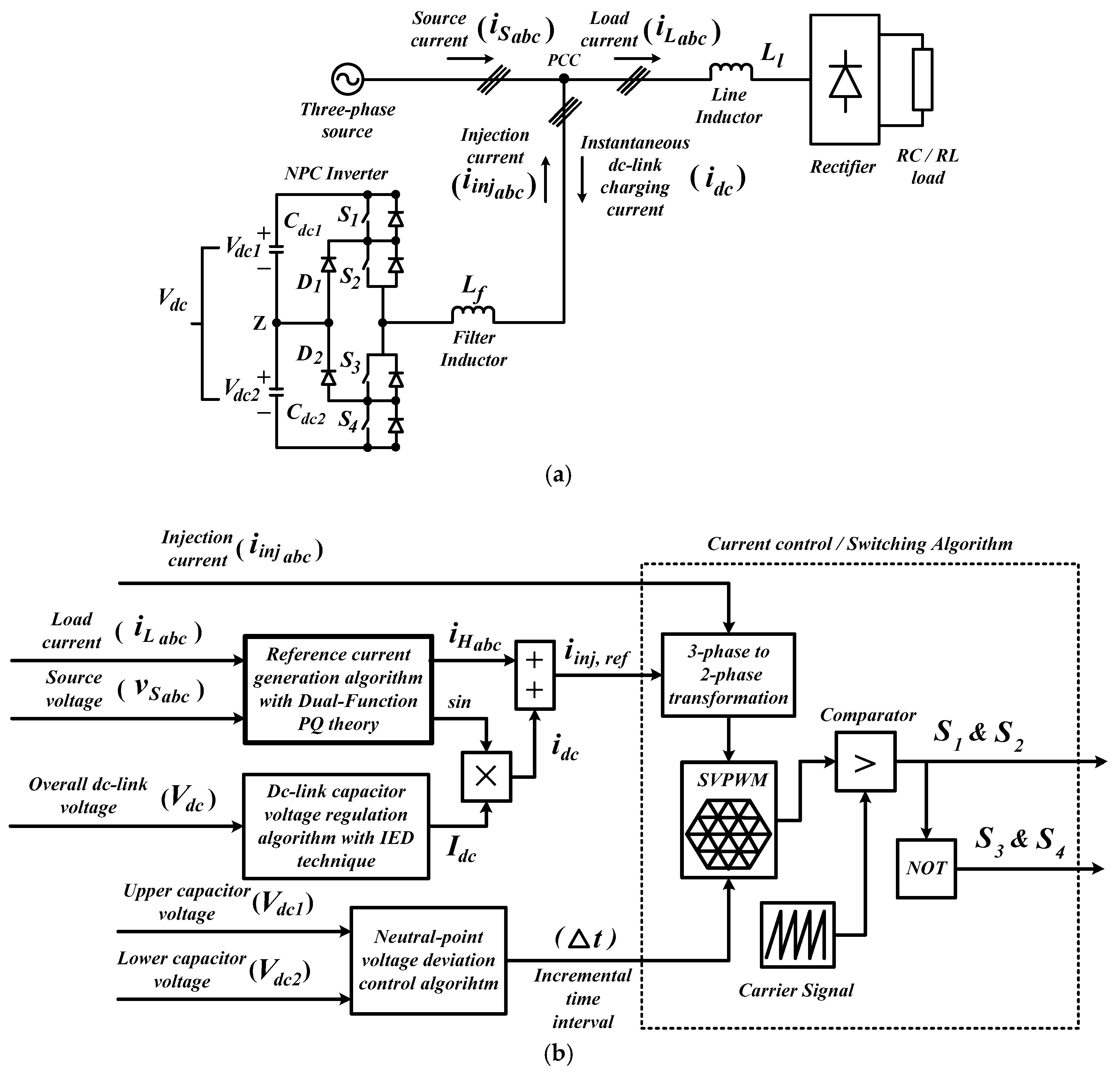
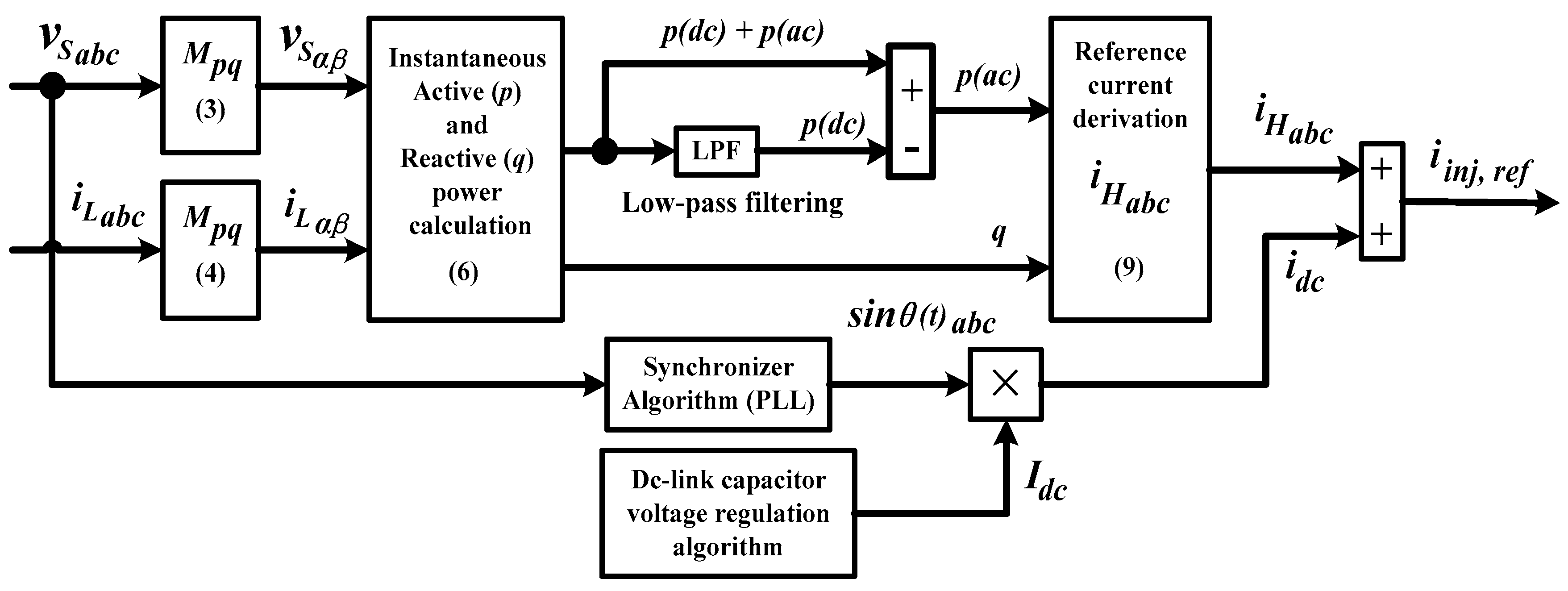
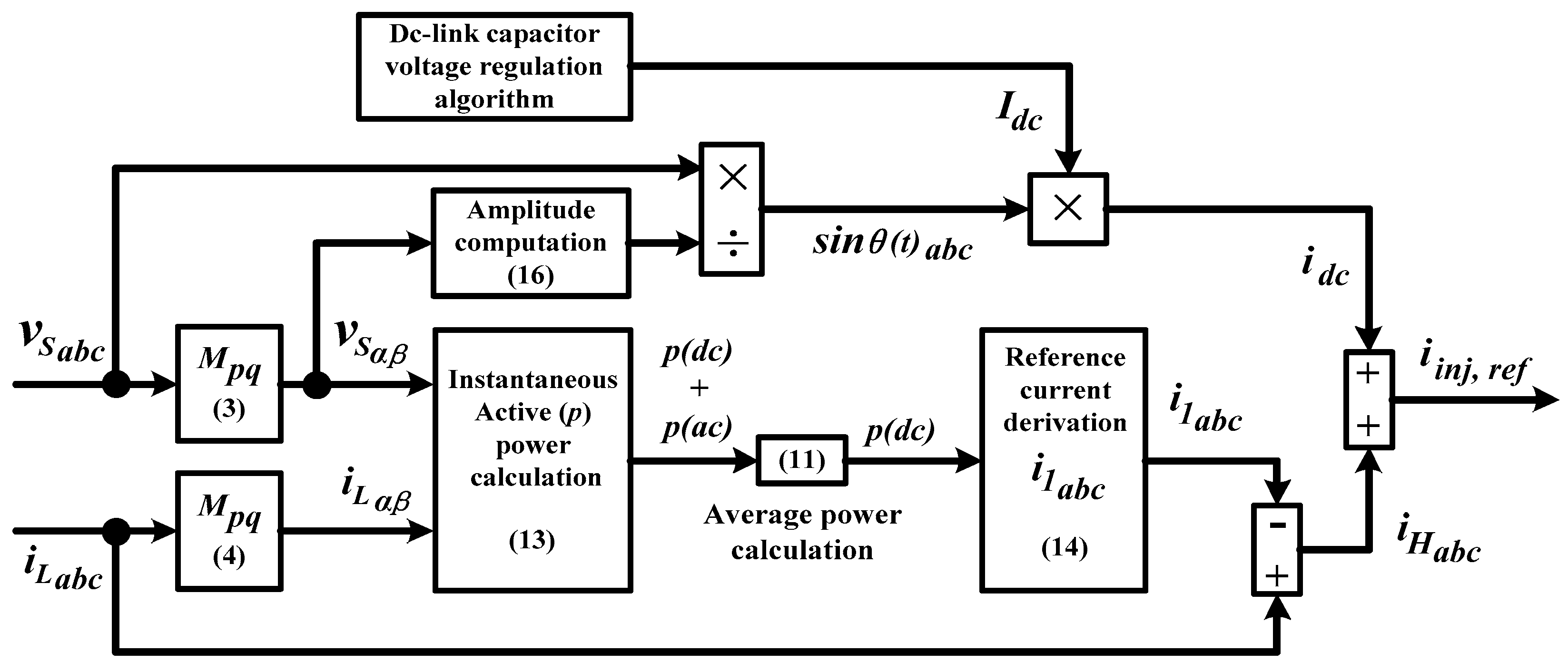
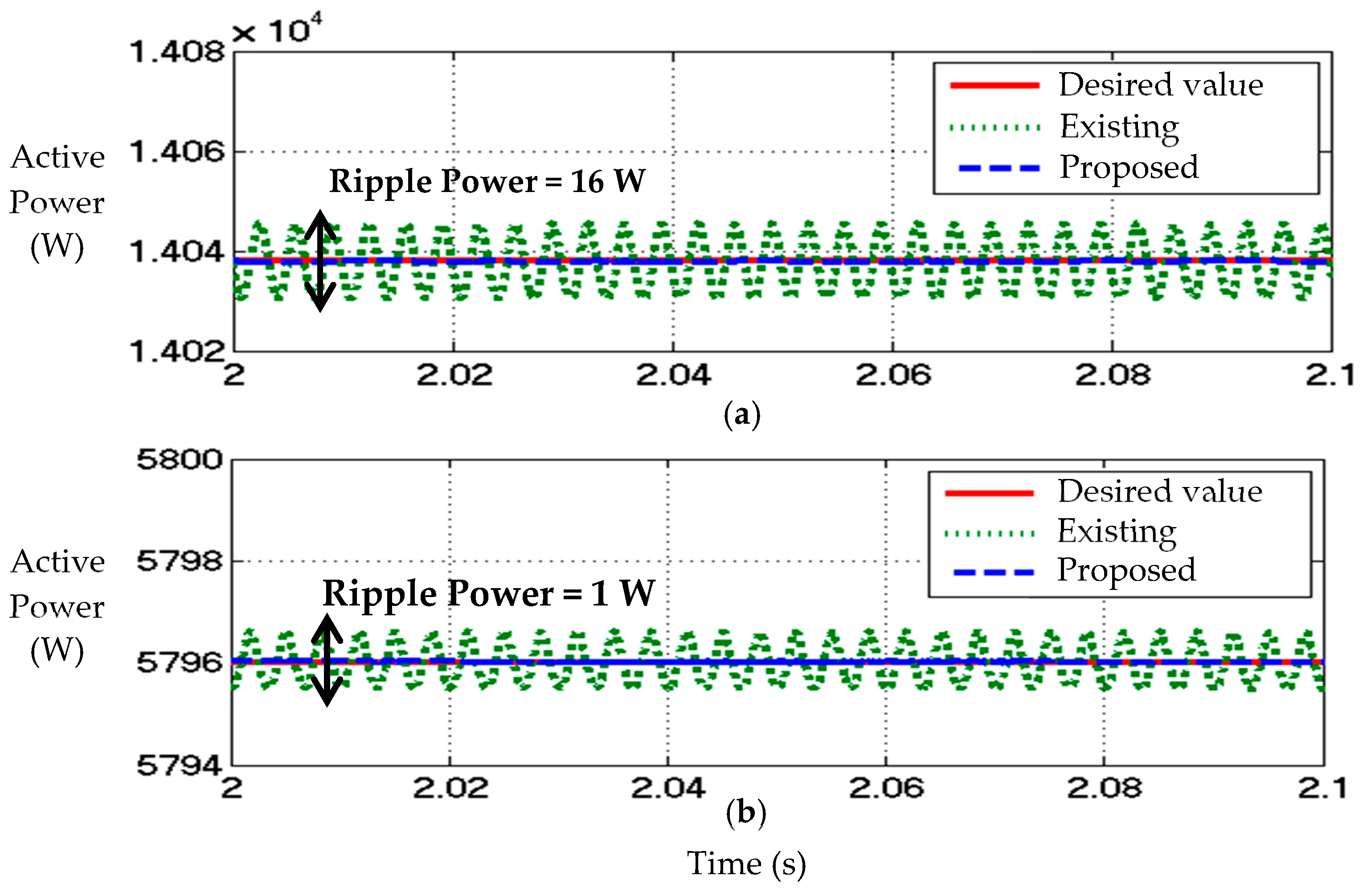

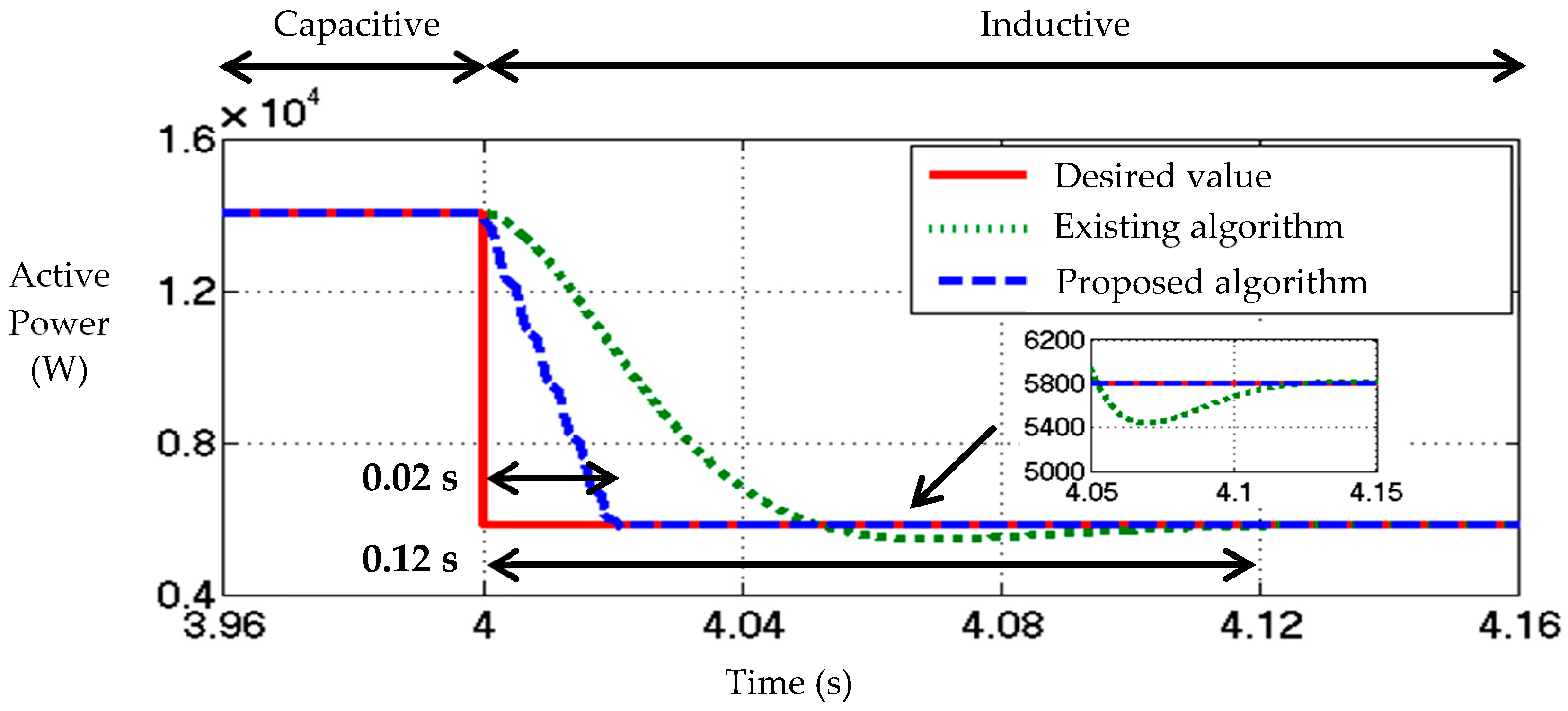

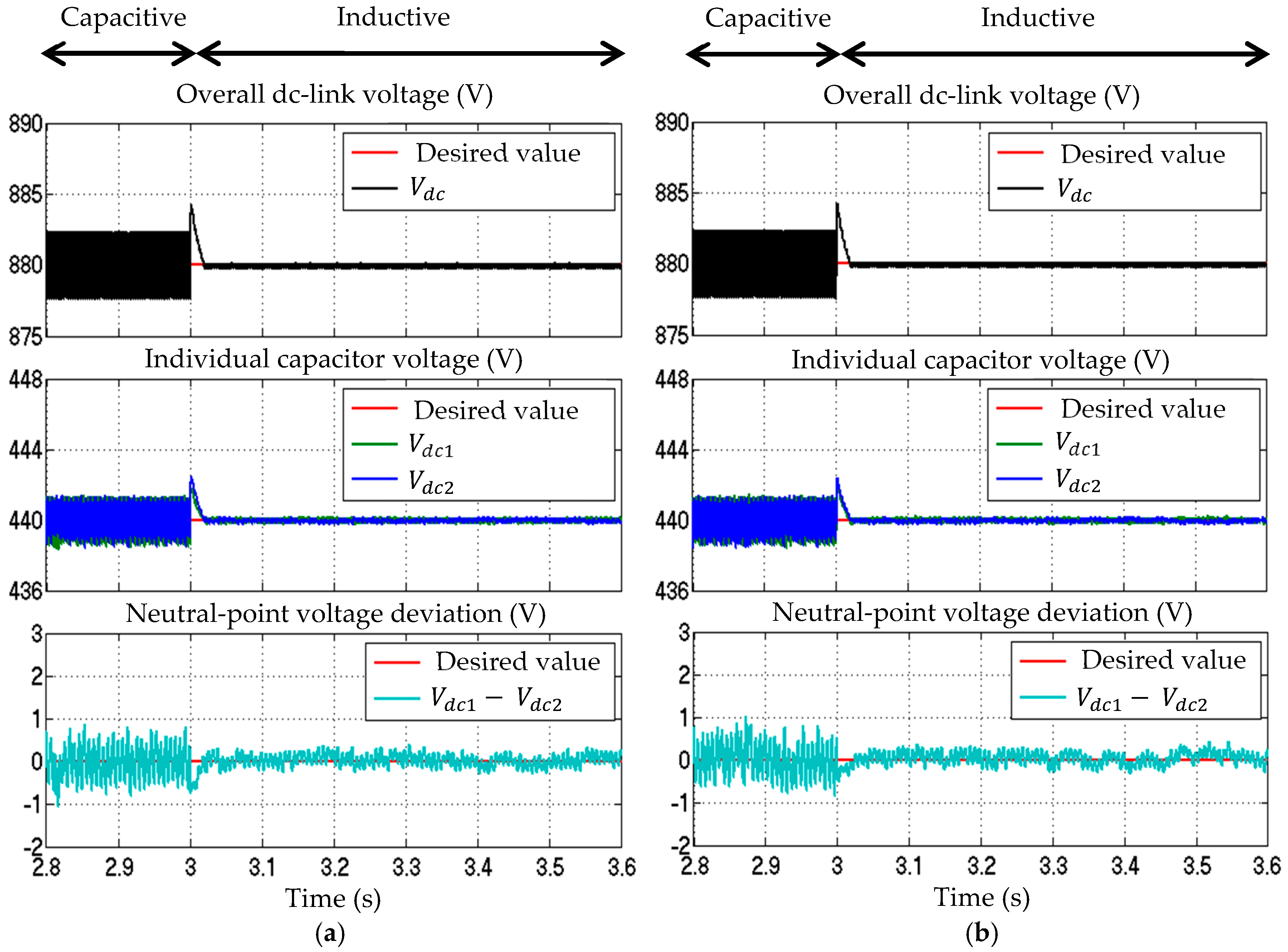
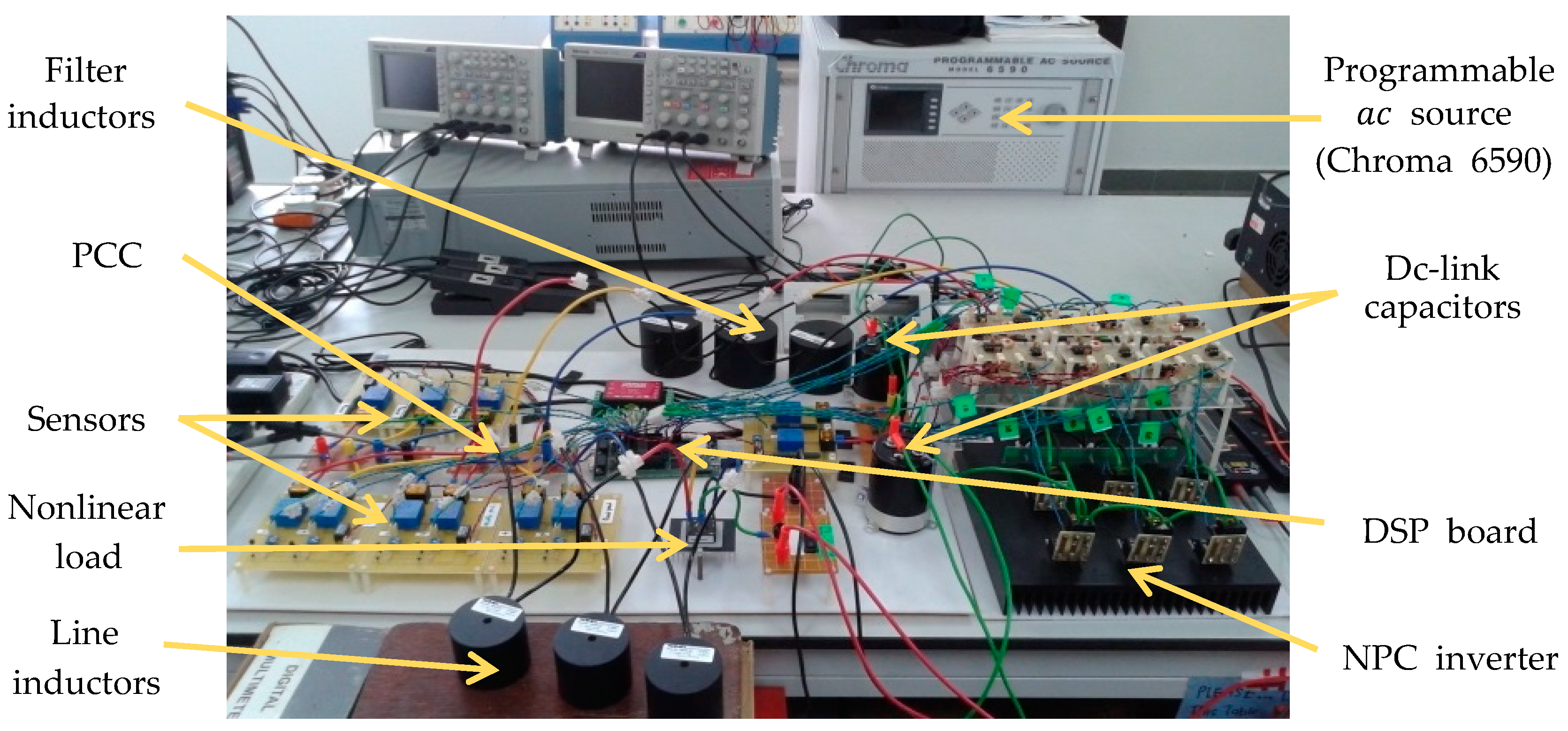
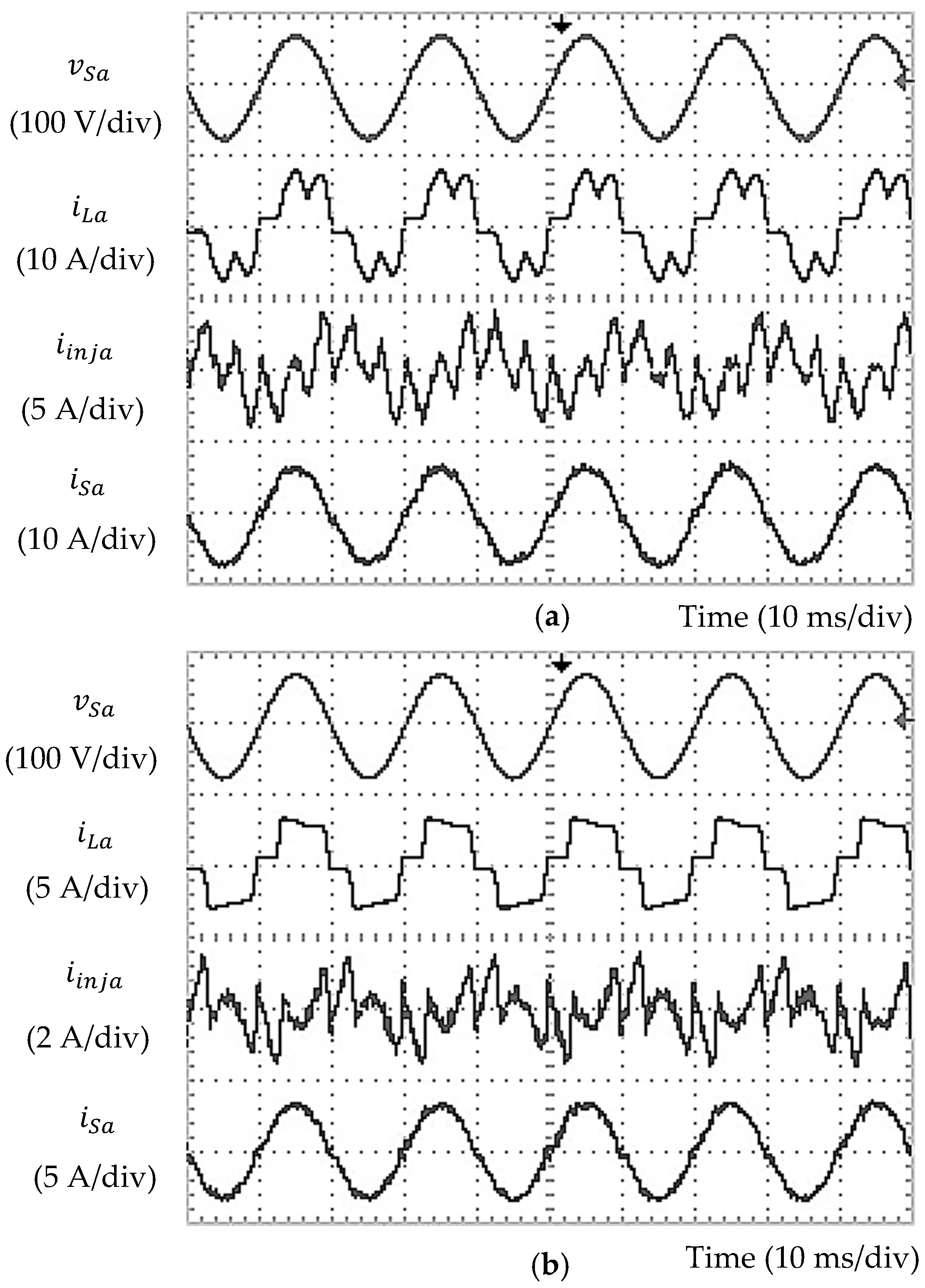

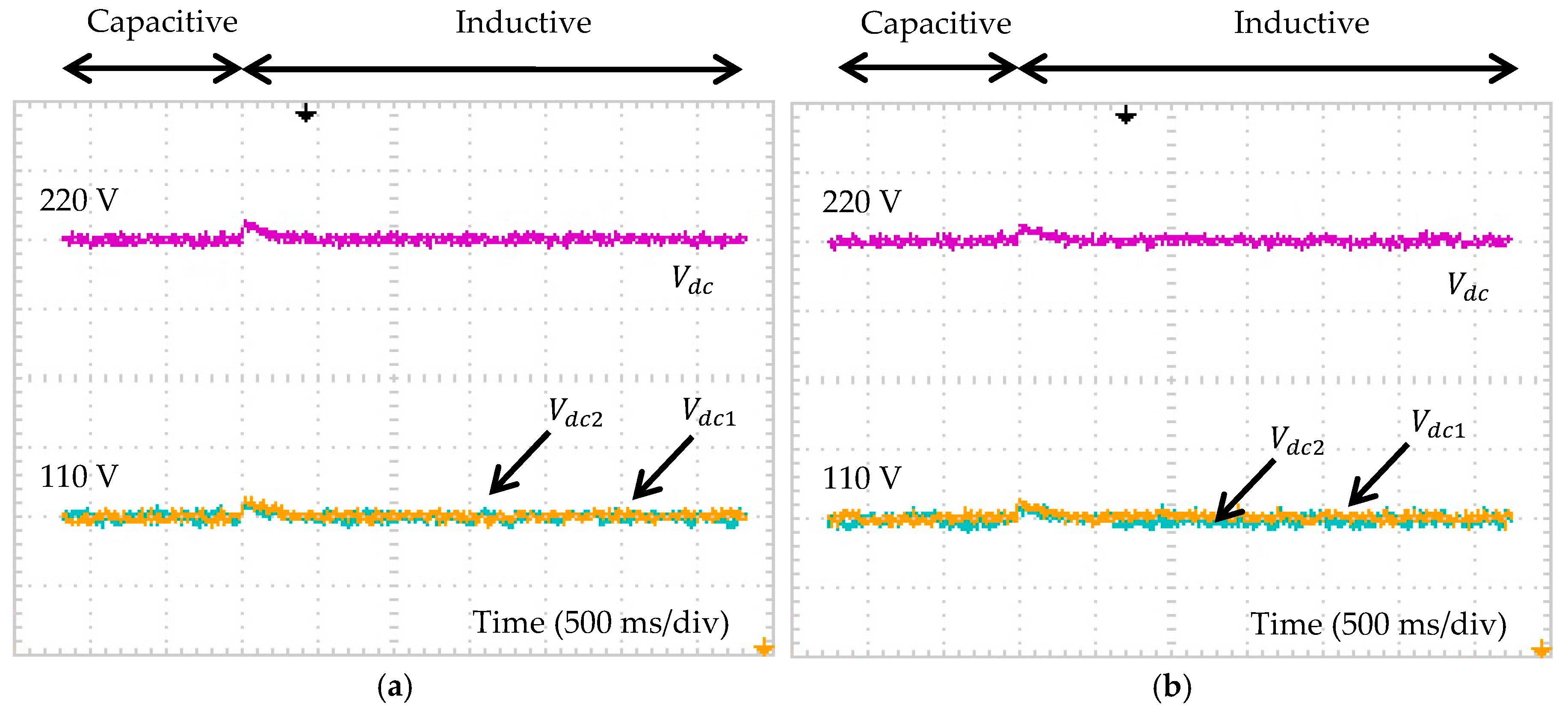
| Reference Current Generation Algorithm | Total Harmonic Distortion, THD (%) | |||||
|---|---|---|---|---|---|---|
| Phase | Phase | Phase | ||||
| Capacitive | Inductive | Capacitive | Inductive | Capacitive | Inductive | |
| Without Installation of SAPF | ||||||
| N/A | 43.03 | 27.34 | 43.03 | 27.34 | 43.03 | 27.34 |
| With Installation of SAPF | ||||||
| dual-function theory | 1.08 | 1.72 | 1.09 | 1.70 | 1.09 | 1.72 |
| Existing theory | 1.17 | 1.83 | 1.15 | 1.82 | 1.16 | 1.84 |
| Reference Current Generation Algorithm | Total Harmonic Distortion, THD (%) | |||||
|---|---|---|---|---|---|---|
| Phase | Phase | Phase | ||||
| Capacitive | Inductive | Capacitive | Inductive | Capacitive | Inductive | |
| Without Installation of SAPF | ||||||
| N/A | 32.14 | 24.62 | 32.18 | 24.65 | 32.11 | 24.66 |
| With Installation of SAPF | ||||||
| dual-function theory | 3.33 | 3.08 | 3.38 | 2.98 | 3.28 | 3.04 |
| Existing theory | 4.10 | 3.92 | 4.16 | 3.83 | 4.06 | 3.88 |
© 2018 by the authors. Licensee MDPI, Basel, Switzerland. This article is an open access article distributed under the terms and conditions of the Creative Commons Attribution (CC BY) license (http://creativecommons.org/licenses/by/4.0/).
Share and Cite
Hoon, Y.; Mohd Radzi, M.A.; Hassan, M.K.; Mailah, N.F. A Dual-Function Instantaneous Power Theory for Operation of Three-Level Neutral-Point-Clamped Inverter-Based Shunt Active Power Filter. Energies 2018, 11, 1592. https://doi.org/10.3390/en11061592
Hoon Y, Mohd Radzi MA, Hassan MK, Mailah NF. A Dual-Function Instantaneous Power Theory for Operation of Three-Level Neutral-Point-Clamped Inverter-Based Shunt Active Power Filter. Energies. 2018; 11(6):1592. https://doi.org/10.3390/en11061592
Chicago/Turabian StyleHoon, Yap, Mohd Amran Mohd Radzi, Mohd Khair Hassan, and Nashiren Farzilah Mailah. 2018. "A Dual-Function Instantaneous Power Theory for Operation of Three-Level Neutral-Point-Clamped Inverter-Based Shunt Active Power Filter" Energies 11, no. 6: 1592. https://doi.org/10.3390/en11061592
APA StyleHoon, Y., Mohd Radzi, M. A., Hassan, M. K., & Mailah, N. F. (2018). A Dual-Function Instantaneous Power Theory for Operation of Three-Level Neutral-Point-Clamped Inverter-Based Shunt Active Power Filter. Energies, 11(6), 1592. https://doi.org/10.3390/en11061592






